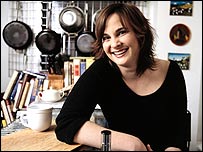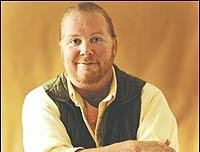Responding to a
meme for my 5 favorite places to eat. It's dang hard to come up with just five, but let's see what happens...
Sammy's Romanian Steakhouse - New YorkMuch more than its name implies, this is a Jewish Experience. It's like going to a Bar Mitzvah in the Catskills. The menu includes most of the "K" foods -- kishke, kreplach, kasha varnishkes. But the steaks
are amazing. Giant strip steaks with an indescribably delicious Romanian marinade. And to dip your bread? Not butter. Not olive oil. But schmaltz. Yes, liquefied chicken fat. Yum! Order Vodka and you'll be served a bottle of Absolut frozen in a block of ice, left at your table in a tub, just like champagne. Remember those old-fashioned seltzer bottles? There's one on your table. When you're done with the main course, your waitress will bring milk and Fox's U-Bet Chocolate Syrup. Those in the know will then mix their own egg creams (no egg, no cream, but it's nectar from heaven) to enjoy with a plate of rugulach. I forgot to mention the entertainment. Depending on the night, you might find a fellow who looks like Bobby Vinton singing and playing Jewish favorites and standards on a keyboard. The owner is the guy with the gold chains, a glass of wine in his hand and bawdy comments at the ready. Not to be missed! Leave your business card on the wall and buy a souvenir T-shirt.
Katz's Delicatessen - New YorkOne of the few authentic Jewish deli's left, this one is atypical. It is set up cafeteria style. You go to the counter, and a counterman makes your sandwich. Order your corned beef or pastrami on club bread for a great alternative to the ubiquitous rye. Enjoy the decor, which includes hanging salamis and a sign dating to W.W.II that urges you to "send a salami to your boy in the Army" (in New York, that rhymes). See my
post from a 2005 visit.
Roscoe's House of Chicken and Waffles - Hollywood and other L.A. area locationsThe name just about says it all. This combination works. Roscoe's is a specialized kind of soul food joint. You'll be greeted by a friendly security guard/mâitre d'. The menu is mostly various combinations of fried chicken and waffles. The chicken is wonderfully breaded and fried, available with or without gravy. The waffles are tender and fluffy. A side order of collard greens cuts through the heaviness of the gravy and syrup.
Billy Goat Tavern - ChicagoMany times, I've walked up Michigan Avenue just north of the Chicago River (one of my favorite spots in any city) and not noticed the sign for the Billy Goat. This time, my friend spotted it and we went down the stairs to a lower level on which cross streets run, to see what it was. Immediately on entering, I realized the import of our discovery. The Saturday Night sketch about a Greek burger joint - "Cheeborger, cheeborger . . . no fries, cheeps . . . no Pepsi, Coke." - was a take-off on the Billy Goat! It was a great cheeborger! I got a double, because the counterman refused to sell me a single. It is served on a piece of wax paper which you take to a fixin' station with onions, pickles, relish and condiments, and then carry to your table. Alert the historic preservation society; the Billy Goat must always stand!
Café du Monde - New OrleansEnjoy fresh squeezed orange juice, that wonderful New Orleans chicory coffee, and beignets at this open air cafe near the waterfront. Beignets are incredibly wonderful, square, donut-like delicacies that are pummeled with powdered sugar. Most mornings, local street musicians will provide a jazz serenade.
OK, I can't stop at five...
Two Lights Lobster Shack - Cape Elizabeth, MaineWhen visiting Maine between late April and early October, enjoy this classic seaside seafood experience. A beautiful, rocky setting just south of Portland. Lobsters, lobster rolls, great lobster stew, fried clams, shrimp or fish. Get a basket with fries, and cole slaw that has a hint of pineapple juice. Dine inside or out.
Arthur Bryant's - Kansas CityIn a city known for its barbecue, this place ranks at the top. First finding national fame in Calvin Trillin's writings in the New Yorker, Bryant's has not been ruined by its celebrity. The key to its success is a uniquely flavored, grainy sauce. Get on line and be served whopping portions of ribs and fixin's on a metal tray. Enjoy your meal in decor that looks like a men's room, but is otherwise pleasant.
Yocco's - Allentown, PA.There are few local/regional fast food joints of distinction left in America, and Yocco's is one. Their specialty is chili dogs. A standard "Yocco's" is a well-done dog in a steamed bun with mustard, chopped onions and homemade chili sauce. I recommend asking for pickles and (banana) peppers. Instead of fries, order fried potato pierogies -- sort of an Eastern European ravioli. Dig their logo which shows an angry hot dog wearing a crown eating...a hot dog.
Brennan's - New OrleansIn the best dining-out city in America, Brennan's has a special place in my heart. This is where I had the most amazing breakfast in my life, and I
love breakfast! The specialty is poached eggs and omelets in many varieties, done to perfection. Have turtle soup as an opener and finish with Bananas Foster (this is where it was invented) made tableside. Make reservations, dress well, and plan to spend more than you ever thought breakfast could cost. Just do it.
Lawry's Prime Rib - Chicago, Las Vegas, L.A.A relic of a bygone age (like the 40's!), with waitresses identified as "Miss Soandso," none of the first-name-phony-familiarity that's run rampant. With the exception of one fish dish, they serve prime rib and prime rib only. Choose from a selection of cuts, carved tableside from a Buck Rogers-ish chrome cart. Salads are served from a bowl that your waitress spins by hand as she drizzles Lawry's salad dressing (a spicy French type) into it. Sadly, they no longer bottle the dressing; you used to be able to take some home. Yes, this is the restaurant that invented Lawry's seasoned salt.
Buckhorn Exchange - DenverA real man's eating establishment, but women are invited, too. The oldest restaurant in Denver at 100+. A kind view of the decor, for non-hunters, is that it's like a visit to the Museum of Natural History. In other words, taxidermy abounds in a setting of rich hardwood. The menu features elk, buffalo, rocky mountain oysters and other game. Preparation and presentation are superb, and the food tastes wonderful, not gamy at all. This is the kind of place to which a gentleman will want to wear a tweed jacket with suede elbow patches, though I don't think there's an official dress code.
Phillippe's the Original - Los AngelesPhillipe's feels like a trip back to the 1940's, but the place is actually older. Founded in 1908, they claim to have created the French Dip sandwich in 1918 by inadvertantly dropping a roast beef sandwich in the gravy. The customer who accepted the soggy meal came back with friends for more, and a menu item was born. Also born was a verbal travesty as other places serve the gravy on the side and refer to their sandwiches as being served "with au jus." You want to upset the French, that's all you need. Me, I'll take the tasty soggy sandwich along with great sides -- cole slaw, served dry, medium or wet, macaroni salad with lots of pickle relish, an outstanding kosher dill pickle, beet-pickled eggs and pickled pig's feet. My friends also tried and liked the beef stew. And you can get dipped sandwiches with lamb or other meats instead of beef. Beer, wine and rich desserts also available. The 1940's feel probably comes from the uniforms of the (counter) servers and the signage.
AQ Chicken House - Springdale, AR.Just a town away from Wal-Mart HQ is another stuck-in-time eatery. They make pan-fried chicken and I've never had any nearly as good. A chicken dinner with sides and ice tea ran about $14 including tip just a few years ago.
I knew I couldn't do just five!

 Aficionados will claim one is better than the other, or that there are better purveyors in Philly than these pioneers.
Aficionados will claim one is better than the other, or that there are better purveyors in Philly than these pioneers.
 I've made these as part of a party spread and cut each roll into three or four pieces.
I've made these as part of a party spread and cut each roll into three or four pieces.





















